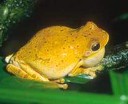
Phyllodytes is a genus of frogs in the family Hylidae. It is endemic to eastern Brazil.
The bromeliad tree frog is a species of frogs in the family Hylidae.

Hyloscirtus albopunctulatus is a species of frog in the family Hylidae found in Colombia, Ecuador and Peru. Its natural habitat is subtropical or tropical moist lowland forests.
The Alagoas heart-tongued frog is a species of frog in the family Hylidae, the tree frogs and allies. It is endemic to Brazil, where it is known from coastal regions in Bahia, Alagoas, and Pernambuco. It has been observed as high as 550 meters above sea level.

Phytotriades is a genus of tree frogs in the family Hylidae. As currently delimited, the genus is monotypic and contains Phytotriades auratus, commonly known as the golden tree frog, bromeliad-dwelling treefrog, El Tucuche golden tree frog, or Trinidad heart-tongued frog.
The Alhandra heart-tongued frog is a species of frog in the family Hylidae endemic to Brazil. It has been observed as high as 100 meters above sea level.

Phyllodytes edelmoi is a species of frog in the family Hylidae endemic to Brazil. It has been observed as high as 650 meters above sea level.
Phyllodytes gyrinaethes is a species of frogs in the family Hylidae endemic to Brazil. Its natural habitat is subtropical or tropical moist lowland forests. It has been observed as high as 710 meters above sea level.

The Brazilian heart-tongued frog is a species of frog in the family Hylidae endemic to Brazil's Atlantic forests. It has been observed as high as 600 meters above sea level.

The yellow heart-tongued frog is a species of frog in the family Hylidae endemic to Brazil. It has been observed as high as 650 meters above sea level.

The Bahia heart-tongued frog is a species of frog in the family Hylidae endemic to Brazil's rainforests. It has been observed as high as 800 meters above sea level.
Phyllodytes punctatus is a species of frogs in the family Hylidae endemic to Brazil. People have seen it as high as 140 meters above sea level.
The Maracas heart-tongued frog is a species of frog in the family Hylidae endemic to Brazil. Its natural habitats are subtropical or tropical dry forests, dry savanna, and moist savanna. People have seen this frog between 900 and 1350 meters above sea level.
Sarcohyla charadricola is a species of frogs in the family Hylidae.

The mahogany tree frog is a species of frog in the family Hylidae found in Belize, Costa Rica, Guatemala, Honduras, Mexico, and Nicaragua.

Phasmahyla spectabilis is a species of frog in the subfamily Phyllomedusinae. It is endemic to Brazil and known from the north-eastern Minas Gerais and adjacent southern Bahia. It occurs in fragments of Atlantic Forest at elevations of about 800 m (2,600 ft) above sea level.People have seen it as high as 850 meters above sea level.

Phyllodytes maculosus is a species of frogs in the family Hylidae endemic to Brazil's rainforests. It has been observed between 77 and 837 meters above sea level.
Phyllodytes megatympanum is a frog in the family Hylidae endemic to Brazil. It has been observed between 90 and 95 meters above sea level.
Bromeliohyla melacaena is a species of frogs in the family Hylidae. It is endemic to the Sierra de Omoa in northwest Honduras where it has been recorded from Cusuco National Park and Merendón Reserve.

Phyllodytes praeceptor is a species of frog in the family Hylidae endemic to coastal areas in the state of Bahia in Brazil. It has also been seen in Serra da Jiboia, 694 m above sea level.











